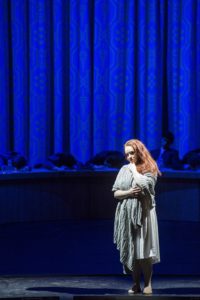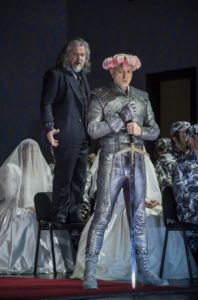The picturesque Krefeld on the Rhine – in the 18th century one of the most flourishing centers of the textile industry in Europe – awaited the Knight of the Swan almost as long as did Warsaw. Lohengrin inaugurated the 1952/53 season in the freshly-opened building of the Staatstheater, erected according to a design by Eugen Bertrand on the foundation of the unfinished garrison theater of the British occupation forces. The makeshift building was supposed to undergo further expansion which was delayed by the architect’s sudden death. Its present, late Modernist form was given to it by Gerhard Graubner, who provided it with a characteristic three-dimensional façade made of glass lozenge panels, retaining the original design for the auditorium and the stage. Graubner’s theater opened its doors in 1963, two years after the next staging of Lohengrin, which continued its run until 1977. The return of Wagner’s Romantic opera after a 40-year absence was announced as the biggest event of the season in Krefeld – from my viewpoint all the more interesting that the knight of Elsa’s dreams was supposed to arrive in the person of the same singer who portrayed the role of Lohengrin at the Teatr Wielki – Polish National opera in April 2014. Peter Wedd had debuted in this role somewhat earlier, at the Moravian-Silesian National Theater in Ostrava; most opera lovers, however, associate him with the poetic staging, laden with hidden meanings, of Antony McDonald. It was time for a change: the third post-war Lohengrin in Krefeld was directed by Robert Lehmeier, an experienced music theater person, formerly an assistant to Harry Kupfer in work on the Ring at Bayreuth in 1988.
The first rehearsal pictures augured the worst: a typical German Regieoper with the ladies in business attire, the gentlemen in three-piece suits, and the title character in an absurd costume like something out of a cheap sci-fi film and an even more absurd wreath of roses adorning his temples. Meanwhile, Lehmeier’s staging turned out to be in many respects a beautiful catastrophe. I had the impression that the director had undertaken a risky attempt to dialogue with McDonald’s concept – an attempt on the whole unsuccessful, with several ideas far beyond the bounds of his charge, but realized reasonably consistently in two parallel narratives: the power crisis in the face of impending conflict, and the loss of illusions on the part of the two innocent lovers. Lehmeier – in collaboration with stage designer Tom Musch – played out his Lohengrin in an abstract space, nevertheless intelligently suspended between contemporary times and the world of medieval legend. The castle in Antwerp is crowned by defensive crenellations, but the decor of the room in which the divine judgment of Elsa will take place evokes unambiguous associations with UN headquarters in New York. The wallpaper on the walls and the curtain hung at the rear are a near-literal imitation of the fabrics designed by Else Poulsson that adorn the interior of the Security Council meeting room. Near-literal, because the director and stage designer substituted the motif of three ears of grain – symbolizing the hope of rebirth – with a perverse version of a caduceus, with the two snakes wrapped around a sword. The courtiers’ formal costumes and the Brabant warriors’ field uniforms contrast sharply with the floral accents in the clothing of the two main protagonists, outsiders as lost in reality as American flower children at the first Woodstock festival (costumes by Ingeborg Bernerth). Visually, it would have made up a quite convincing whole if it weren’t for Lohengrin’s grotesquely ugly ‘space suit’, which at least until the end of Act I effectively distracted one’s attention from the singing floating out from the stage.
Izabela Matuła (Elsa). Photo: Thomas Esser.
But we must grant Lehmeier this: that he guided every one of the characters very competently and breathed real life into them. Whether he did this in line with the composer’s intentions, is quite another matter. McDonald also reinterpreted the work in a quite daring manner: his Lohengrin leaves Brabant to the disenchanted Gottfried, who turns out to be completely immature in his leadership role and begins a mortally dangerous war game. But that isn’t until the finale. In Lehmeier’s rendition, Heinrich der Vogler doesn’t care a whit about Elsa and Lohengrin’s love from the very beginning – he sees the mysterious visitor in the silver armour exclusively as a tactical ally in the impending conflict. Thus, Gottfried’s final entrance with machine gun in hand does not evoke the expected effect. In McDonald’s rendition, Lohengrin is touchingly awkward, thirsty for love, torn between knightly obligation and husbandly duty. In Lehmeier’s rendition, he is a ‘chip off the old block’ with respect to Parsifal – and that, from the first act of Wagner’s opera. He really knows nothing at all: neither what to do with a sword, nor how to fulfill the expectations of that strange being who called him from Monsalvat. To the sounds of the orchestral prelude, a pantomime plays out: Elsa loses sight of little Gottfried, who is wearing the same kind of flower wreath as Lohengrin does later, and submerges herself in an erotic fantasy about a naked youth with roses adorning his temples and a shining sword in hand. Throughout Act I, she remains in a strangely drugged state. Her fantasy is finally fulfilled, but only superficially. In the subsequent plot process, we observe Elsa’s progressive disappointment with the mysterious visitor, who clearly is fit neither for battle nor for bed, nor even for the most ordinary human friendship. When Lohengrin loses his flower (in other words, he loses his innocence by killing Telramund), Elsa again gives herself over to dreaming and presents both his wreath and his sword to a symbolic figure of her lover, who again appears at the rear of the stage.
But despite everything, it’s still watchable. From the morass of overwrought, controversial and simply erroneous interpretations, one picks out a few brilliant scenes, a few gorgeous theatrical shortcuts. In Ortrud and Telramund, Lehmeier has discerned characters yet more tragic than McDonald suggested. Running through the background of their conspiracy in Act II is the authentic determination of two people who must carry out a double play in order to defend their convictions. In Ortrud’s later dialogue with Elsa, one clearly senses the moment when Telramund’s wife breaks down and truly sympathizes with the unfortunate bride. In Act I, just before Lohengrin’s entrance, the dismayed choristers begin to literally ‘crawl’ with feathers: they pull them out of their hair and the nooks and crannies of their clothes, and disgustedly brush them off their stockings and shoes. A superb metaphor for surprise bordering on panic, considerably more convincing than the hands waving overhead that have been played to the point of boredom. During the wedding night scene in Act III, Lohengrin tries to catch the fleeing Elsa and for a moment, he succeeds: in a horrifying gesture of immobilizing a wild animal that freezes in his embrace as if paralyzed.
Eva Maria Günschmann (Ortrud) and Izabela Matuła. Photo: Tomas Esser.
Nevertheless, as much as the theatrical side left a lot to be desired, the musical layer exceeded my boldest expectations. The Niederrheinische Sinfoniker ensemble under the baton of Estonian Mihkel Kütson, since 2012 the artistic director of Theater Krefeld und Mönchengladbach, played with nerve, at superbly-chosen tempi, but at the same time subtly, with a wonderfully soft sound that beautifully lit up the texture, especially in the wind parts. Four ‘Königs-Trompeten’ in C, brought in from Bayreuth, lent an appropriately powerful sound to the fanfares. The expanded chorus was impressive in its diction, clear vocal production and skill in dynamic diversification of phrasing. In the solo cast, there were basically no weak points, except perhaps for Andrew Nolen in the role of Herold, who was insufficiently expressive and often insecure in intonation. Matthias Wippich, gifted with an extraordinarily charming and overtone-rich bass voice (somewhat resembling the young Gottlob Frick in colour), convincingly portrayed the role of the charismatic and, at the same time, demoralized Heinrich der Vogler. Johannes Schwärsky created a Telramund of flesh and blood: here arrogant, there demonic, sometimes shockingly helpless in conflict with reality. His thick bass-baritone is astonishing in its flexibility and sonic power – at times too big, especially in his duet with Eva Maria Günschmann, who has at her disposal a deep, superbly balanced in terms of registers but all in all quite delicate mezzo-soprano voice. In terms of the acting, her Ortrud turned out to be a masterpiece – if the singer had been able to distribute her strength better and save up reserves for Act III, she would have built a character perfect in every detail.
The performers of the two lead roles would be a jewel adorning any production of Lohengrin: on any stage, not only in Europe. I write this with full conviction, and pleasure all the greater that the role of Elsa was sung by Izabela Matuła, a graduate of the Academy of Music in Kraków, a memorable title character in Maria from shows of Roman Statkowski’s forgotten work, prepared in 2013 under the baton of Łukasz Borowicz on the stage of the Baltic Opera. Her soprano has always been enchanting in its charm, peculiar dark colour and soft, somewhat ‘old-world’ vocal production. Now it has gained in refinement, taken on security of intonation and dramatic expression, thanks to which the singer succeeded in building an Elsa who, over the course of the narrative, goes through an amazing transformation from a teenager floating on clouds to a bitterly-disappointed woman. Peter Wedd, who had sung Lohengrin three months before in Athens with a voice as if from Götterdämmerung – truly heroic, indeed overwhelming in its authority – this time rediscovered layers of intense lyricism in his role, supported by superb breath control and feeling for phrasing. The director set him a difficult task, squeezing him into the role of a disoriented honest-to-God simpleton – despite this, Wedd emerged from this trial victoriously, proving that he is now not only in control of the power of his Heldentenor, but also able to diversify its sound. In the Krefeld Lohengrin it resounded with silver; in Athens, steel; in the Karlsruhe Die Walküre, the brilliant golden blaze of brass. This is a case, rare in today’s vocal world, of a singer who identifies completely with his characters and is able to shape a role with purely musical means.
Johannes Schwärsky (Telramund) and Peter Wedd (Lohengrin). Photo: Thomass Esser.
If Lehmeier’s staging had equaled the sonic plane’s coherence in the Krefeld Lohengrin, I would be the happiest opera critic in the world. But there are no miracles. Apparently that was what this show was supposed to be about. That the good of nations does not depend on dubious men of the moment. That love cannot be built upon one’s own imaginations concerning one’s beloved. That one should not count on a revelation, but patiently forge one’s lot in life. The musicians succeeded. The stage director needs to put in more work.
Translated by: Karol Thornton-Remiszewski



